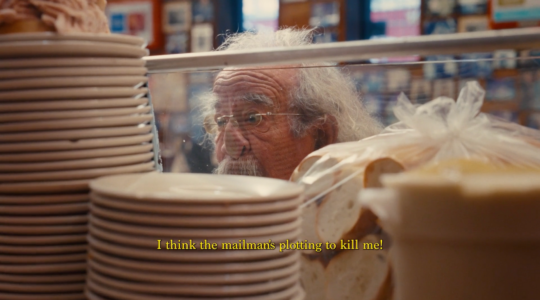About halfway into “Howl,” the edgy, thoughtful new docudrama by Rob Epstein and Jeffrey Friedman, you begin to realize that, in his uncanny recreation of Allen Ginsberg’s speech and performance rhythms, James Franco is beginning to edge into an series of incantatory rhythms not unlike that of a chasid in the throes of ecstatic prayer.
It’s a telling moment, keenly observed, that places Ginsberg not only in the chain of tradition of that master of the long line, Walt Whitman, but in the wake of the same waves of chasidism that Whitman himself apparently knew. And when Franco/Ginsberg describes his writing as seeking “a rhythmic articulation of feeling” that begins in the pit of the stomach and travels with the breath to the head and mouth, he is, wittingly or not, describing the same combination of breath and prayer that other Jewish mystics have invoked.
That’s not to say that Epstein and Friedman think that Allen Ginsberg was a closet Lubavitcher. It is clear from “Howl” that Ginsberg wasn’t in any closet you can name. It is his greatest strength as a poet, writer and human being that Ginsberg was utterly, nakedly himself. It is one of the greatest strengths of this adventurous, if not always fully realized film that Franco’s performance, always front-and-center, has the same kind of fearless honesty that the poet himself had.
“Howl” is a first fiction film for the Epstein-Friedman team, distinguished documentarians responsible for “Paragraph 175” and “The Celluloid Closet,” and the film has the feeling of a couple of artists let out of a formal straitjacket. While their documentaries are invariably excellent, they are formally rather conservative. “Howl,” however, is experimental in the best sense, a bold attempt to find a visual language and rhythmic patterns equivalent to the title poem’s thrumming, urban beat, its soi-disant “bop apocalypse” and “bop kabbalah.”
The film is held together by three distinct motifs, each with its own visual grammar. The story of Ginsberg’s creation of the poem is told through a series of scenes of the poet being interviewed by an unseen interlocutor, bathed in an almost golden yellowish-green sunlight. These sequences are juxtaposed with black-and-white footage of him reading from “Howl,” and color recreations of moments from the obscenity trial of the poem’s publisher Lawrence Ferlinghetti, in something like sepia-tone. These sequences are held together by the photographic brilliance of Ed Lachman (“I’m Not There") and imaginative production design by Therese DePrez, who help provide visual motifs that subtly carry over from sequence to sequence.
Therein lies the organizing principle of the film, a sort of visual counterpart to Ginsberg’s highly effective use of repetition, scattered like matched individual tiles through a larger mosaic. Epstein and Friedman make cunning use of animated sequences by Eric Drooker to take the film’s visual design to a higher level, invoking visual elements picked up from the poem itself. Occasionally, the results are a little flat-footed, but for the most part Drooker’s work avoids the obvious one-to-one correspondence that would reduce these passages of the film to bone-headed literalism.
It’s a spirited and courageous choice, particularly for a couple of filmmakers who have made their reputations in nonfiction film. Ironically enough, Drooker’s animations and the pyrotechnics of the film’s overall structure make the traditionally fact-based scenes in the courtroom seem a bit stodgy by comparison, and while the sparring between Jon Hamm as Ferlinghetti’s razor-sharp lawyer Jake Erhlich and David Strathairn as the almost child-like prosecutor, is occasionally amusing, it doesn’t seem to fit the rest of the film. As a result, one has the rather odd feeling that those sequences, ostensibly the film’s raison d’etre, were grafted on as an afterthought, the “socially redeeming value” needed to please would-be censors. As a result, “Howl” falls a bit flat as a defense of freedom of expression.
On the other hand, in its echoing of Ginsberg’s defiant acceptance of his sexual orientation as “a catalyst for self-examination . . . and the reasons why everyone else is different,” the film is a splendidly unconventional anthem for outsiders and outcasts of every stripe.
“Howl,” directed, written and produced by Rob Epstein and Jeffrey Friedman opens Friday, Sept. 24 at the Angelika Film Center (18 W. Houston St.), Chelsea Cinemas (260 W. 23rd St.) and Lincoln Plaza Cinemas (1886 Broadway, at 63rd Street).
The New York Jewish Week brings you the stories behind the headlines, keeping you connected to Jewish life in New York. Help sustain the reporting you trust by donating today.




